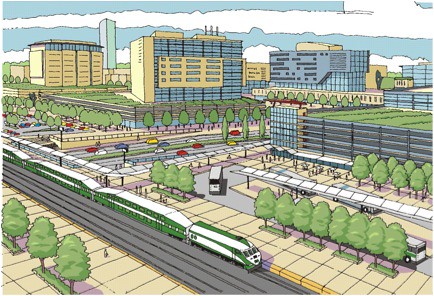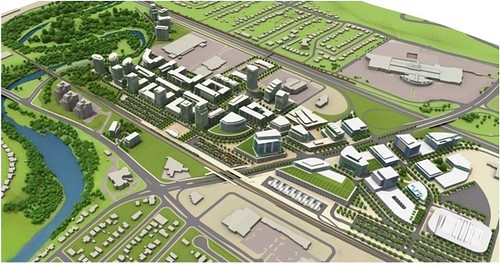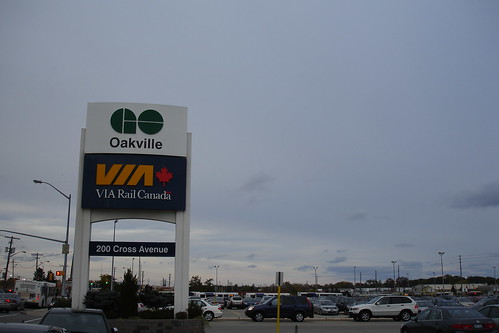
GO Transit is in the throes of major expansion. Examining how the system’s stations influence their surroundings, and how this, in turn, affects the suburbs, can provide a glimpse into the future of the GTA.
As an example of the potential for what GO transit could do for the suburbs, Oakville Midtown is fertile fodder for the imagination. Oakville’s midtown provides several unique and highly desirable characteristics, including a large wooded ravine, natural heritage, and large-scale public land ownership. The exciting redevelopment plan for Oakville’s midtown is an example of how enhancing the areas around GO Transit stations (an initiative central to the Ontario government’s Places to Grow Act) could help fix the suburbs while at the same time solidifying the feasibility of the region’s existing transit infrastructure.
Oakville’s Midtown Core development is centred on the Oakville GO station, in the area bound by the Sixteen Mile Creek, the QEW and the Oakville rail yards. The Midtown plan calls for a redrawn street grid, new civic facilities, an educational campus, and conversion of surface parking into two large garages. The area could host upwards of 5,500 new residences and around two million new square feet of office and commercial space by 2030. Designed to create a focus for the neighbourhood, the civic centre proposal includes a new town hall, marquee arena, and public square.

Exciting proposals also include centering the GO platforms over Trafalgar Road and connecting the station with the future Trafalgar Road Bus Rapid Transit Line between Midtown Oakville and the 407. To integrate the new community into the rest of the town (the area currently follows Oakville’s tradition of isolating residential areas from the QEW/Railway corridor) the project also calls for new road connections and new mixed use and pedestrian/cyclist crossings over the QEW. Surface parking will be reduced to a strip along the north side of the tracks, while the former parking lot will become a new high-density residential community. Commercial interest will be focused around Trafalgar Road. The east end of the area will be allotted for educational and employment uses.
Converting what is now a 2,700 space surface parking lot and derelict industrial lands into a modern new community will be driven by orientation around high-order public transit. The Oakville Midtown has potential for this as a Metrolinx Hub. Oakville’s GO station is one of the busiest in the system and is also serviced by multiple GO bus routes, Amtrak and VIA services. A new Bus Rapid Transit route along Trafalgar would further enhance its position as the existing hub of Oakville Transit.

If the plan is to be fully realized, Oakville (and the suburbs as a whole) will first have to address fundamental challenges in changing the transportation habits of its residents. Although some of the ideas in the project may never see fruition, the concept represents considerable gains for a place like Oakville. Within a sprawling bedroom community, it is certainly a bold new discourse. It seems to be a cut above other failed suburban smart-growth initiatives (such as the Wal-Mart oriented uptown core, further up Trafalgar Road); new levels of pedestrian and transit orientation, as well as a focus on interconnections, give this project great cause for hope. The redevelopment was passed into policy in June 2009 as part of the city’s new Official Plan.

Renderings courtesy of Urban Strategies Inc. Photo by Marcus Bowman.




21 comments
Quite impressive – Much better than the ocean of parking:
http://bit.ly/7KcyXr <–(google maps sat image)
I remember going to Oakville last winter and braving the desolate wait at the GO station for local transit to get me to Lakeshore – the town’s main street and traditional downtown.
Speaking of which, one has to wonder what will happen to main street Oakville over time. In the context of recent spacing posts on “GTA’s lost villages” we should be making sure we don’t lose anymore going forward.
Marcus,
Could you explain or expand this for me?…..
“If the plan is to be fully realized, Oakville (and the suburbs as a whole) will first have to address fundamental challenges in changing the transportation habits of its residents.”
I realize no such thing is actually being proposed, but yellow pavement would be neat to see. The grey of concrete wearies on me.
“fundamental challenges in changing the transportation habits of its residents”
Will change when oil hits $200+ a barrel. Which of course will be sooner than the GO or any other major public transit upgrades come online. Food or Gas will be the ultimate choice for the majority. Even in Oakville.
jk
I’m going to go out on a limb and hypothesize that this could actually reduce public transit use at the Oakville GO station. If there isn’t enough parking people are either going drive to work or drive to a different GO station. While it would be convenient for those living in this new neighbourhood designed around the station, I think the majority of riders using Oakville station are not going to be living in this community.
The community around this GO station also needs to address huge traffic flows otherwise it will be ensnarled in traffic mayhem 4-6pm every weekday. Simply look at any Go station in the Durham region. Its a nightmare trying to move around the parking lots, let alone a community. From what that map shows, its no where near enough parking spaces. I doubt people are willing to add a bus trip to what can already be a long commute.
I like the concept of building communities around public transit but reducing the number of parking spots is too impractical for the majority of riders. Parking reduction will not change transit views…
Glad they are getting rid of those expansive parking lots and putting up verticle parking garages. With the increased service planned for GO and all the regional and city buses using this hub it will be a real dynamic transit hub and a real bustling downtown for Oakville. This is the type of development that is really going to help the Greater Toronto and Hamilton area.
If the plan is fully developed, I would expect Oakville in time to look something like this:
http://bit.ly/8PmduT
(Go to streetview to see the elevated platforms and relative height of the buildings)
It’s certainly feasible. Whether you consider creating mini-downtown White Plains at various GO stations as being of highest and best use vs transfer facilities that are ugly but, as Nathan points out, efficiently get people out of their cars, is an interesting discussion.
Glen,
The statement about changing suburban transportation habits was meant to address problems that have plagued other smart growth initiatives in that past. Specifically, thinking about the the Oakville Uptown core which was intended to be pedestrian oriented but was realized as a big box development becuase Oakville consumers drive, and don’t walk to their shopping destinations. Oakville is an overwhelmingly car oriented city and I would argue that it is difficult for new commerce in more urban environments to compete with businesses that offer sprawling amounts of free parking. Also, to reduce parking at Oakville GO as usage grows, more people will have to be coaxed into using transit to get from their homes to the station.
Nathan, I think your comment is interesting and definitely represents a real risk if this is not done properly. But if you visit GO stations on the Lakeshore line during the day you will see cars parked on medians for lack of any other space. Parking is already a critical issue at many stations during the work week. Increasing transit orientation or moving to large garages is the only to continue ridership growth. Also, its my understanding that large parking garages will be built, by no means does the plan advocate elminating all parking.
Nathan, I think the plan involves multi story parking facilities rather than surface parking.
The 200$ a barrel is a great soundbite but one that I never hear and is waaaaaay more disturbing is what happens when somebody invents a cheap powerful non-polluting battery? Everybody will run out and start driving everywhere again.I would like to see arguments made based on why public transit is better regardless of the price of oil.
If services like daycares were placed on reclaimed transit parking lots, it would remove one of the usual reasons why people choose to drive to the GO station or not use GO at all. To understand modal shift you have to understand riders’ entire routine, not merely that they leave work with the sole intention of getting to their downtown office. It has to encompass both morning and evening tasks and routines, and give reasonable weight between occasional needs and everyday stops.
Oakville Station is a bit different from almost all others on Lakeshore West save Aldershot – it’s a VIA stop. This means it has a larger total catchment from areas where the train doesn’t stop at the GO halt, and transit is likely to find it more difficult to serve that market.
The first step in fixing the suburbs means the province setting sustainable (ie higher) density targets and putting a cap on developing any new areas (re Simcoe)… If this doesn’t happen, all the transit hubs in the world (or GTA) will not make much difference… not likely to happen though since that will adversely affect developers or land speculators still holding large parcels… trying to address transit/transportation issues without addressing density and other land use issues is really just a shell game.
Nathan: driving to another GO station such as Bronte means paying more to ride GO since Bronte is in the next zone and also doesn’t have as large a parking lot. Clarkson is the next station east and while one zone closer it isn’t the easiest to get to unless you take the QEW, and there are also fewer express trains. I think the thrust of this community isn’t necessarily to draw people from the existing neighbourhoods, but to attract new residents who would commute as part of the plan to grow the population. There is already some commercial activity nearby to the north and south so it wouldn’t be in the middle of an amenity desert.
J: Main street Oakville is alive and well. The Lakeshore commercial strip is healthy and is a destination for upscale shopping. The Kerr St. commercial area is the poor cousin, but because of that it has some interesting shops. The Bronte village also has a lot of local flavour and none of these areas really compete with the big box complex at Burloak & the QEW.
Nathan wrote:
“If there isn’t enough parking people are either going drive to work or drive to a different GO station.”
Kevin’s comment:
Switching to driving on the QEW is a non-starter. It is already way over capacity. Indeed, I know many present QEW drivers who would switch to GO if GO had more reliable service.
As to driving to a different GO station, this simply means that car parking has to be steadily reduced at all GO stations.
Thanks for the great comments. Mark you’re right to say that there is great potential here to orient transit around people’s lives. Looking at transit systems around the world, I think the most successful and progressive ones all understand and work towards this. This will be important for agencies such as GO and Metrolinx to understand as development along existing transit corridors not only serves to improve the suburbs but also to enhance the profitability of our existing transit infrastructure.
In terms of downtown Oakville, I don’t think midtown represents a threat to it. Downtown Oakville has a gained a niche as an upscale specialty marketplace and as such doesn’t really compete directly with other, more practical retail.
I don’t see any problem with the lazy types driving to another GO station and parking there…
I don’t see even a battery that could hold enough power to run a tractor trailer for 1,000,000 km and is less then a 10cm cube and weighs less then 1kg, would allow people to start driving everywhere again, after oil gets too expensive to burn.
The problem is that batteries need to be charged, so where do you get the power to charge the battery> We barely have enough electric power generation to deal with current needs. Replacing all gasoline powered cars with electric ones, would require at least a doubling of electrical generating capacity. Oil is out, natural gas is not too far behind, that leaves green power (water, wind, solar, wave) which is still no where near meeting current needs, coal and nuclear. I don’t think you could get a coal plant authorized, ever again. That leaves nuclear. To go from thought stage to power stage can take anywhere from 20 to 30 years.
To fix places like Oakville properly you really need something along the line of Transit City, for example a streetcar going along Lakeshore Rd, and another up Trafalgar Rd.
I don’t drink, but I enjoy going for rides in the car, see. Could something like this work in a smaller town, such a Delhi?
-Nance
Looks great, but one element that hasn’t been discussed is for GO to be using smaller trains more frequently (perhaps something akin to Germany’s S-Bahn services) and saving their “monster trains” for rush hours. This would help mitigate some of the waves of cars entering/exiting the area and help to reinforce this as an all-day hub where you can come and do things, but not always be staring at your watch so as not to miss the next hourly train.
@Jason – ideally electrification would be done by means of electric multiple units, so that a train of 12 would either be a group of 2 x 6 or 3 x 4 which could then be run at more or less the same frequency but using less power. The cheap option, buying electric or dual electric locos like AMT Montreal, leaves us pretty much where we are now.
Dear Sir / Madam:
I have 2 comments and suggestions:
(1) I can’t understand why the new VIA station has not been integrated with the GO station. It happens that people from out of town are getting confused about the 2 stations next to each other. In order to entice people to use more public transport, systems have to be integrated, easy to use and convenient. Also, one station would be more efficient and save operating costs. Right now, the personnel at the VIA station is not always busy.
(2) Recently, the train bridge over the 16 mile creek has been widened. I think it would have been meaningfull if a pedestian path would have been added next to the tracks. I cannot accept the argument that this would cause a safety issue. The population on the west side of the 16 mile creek is expanding, and the walk down Speers road and up Cross Avenue could have been shortened sustantially, thereby adding more incentives for people to use public transport.
Those are just 2 examples of missed oportunities!!
Hope my comments are being received as constructive critisism.
Thanks and kind regards
Dr. Stefan Wille